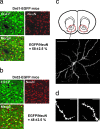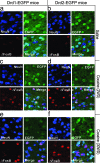Cocaine-induced dendritic spine formation in D1 and D2 dopamine receptor-containing medium spiny neurons in nucleus accumbens
- PMID: 16492766
- PMCID: PMC1413917
- DOI: 10.1073/pnas.0511244103
Cocaine-induced dendritic spine formation in D1 and D2 dopamine receptor-containing medium spiny neurons in nucleus accumbens
Abstract
Psychostimulant-induced alteration of dendritic spines on dopaminoceptive neurons in nucleus accumbens (NAcc) has been hypothesized as an adaptive neuronal response that is linked to long-lasting addictive behaviors. NAcc is largely composed of two distinct subpopulations of medium-sized spiny neurons expressing high levels of either dopamine D1 or D2 receptors. In the present study, we analyzed dendritic spine density after chronic cocaine treatment in distinct D1 or D2 receptor-containing medium-sized spiny neurons in NAcc. These studies made use of transgenic mice that expressed EGFP under the control of either the D1 or D2 receptor promoter (Drd1-EGFP or Drd2-EGFP). After 28 days of cocaine treatment and 2 days of withdrawal, spine density increased in both Drd1-EGFP- and Drd2-EGFP-positive neurons. However, the increase in spine density was maintained only in Drd1-EGFP-positive neurons 30 days after drug withdrawal. Notably, increased DeltaFosB expression also was observed in Drd1-EGFP- and Drd2-EGFP-positive neurons after 2 days of drug withdrawal but only in Drd1-EGFP-positive neurons after 30 days of drug withdrawal. These results suggest that the increased spine density observed after chronic cocaine treatment is stable only in D1-receptor-containing neurons and that DeltaFosB expression is associated with the formation and/or the maintenance of dendritic spines in D1 as well as D2 receptor-containing neurons in NAcc.
Conflict of interest statement
Conflict of interest statement: No conflicts declared.
Figures




Similar articles
-
Acute binge pattern cocaine administration induces region-specific effects in D1-r- and D2-r-expressing cells in eGFP transgenic mice.Neuroscience. 2013 Dec 3;253:123-31. doi: 10.1016/j.neuroscience.2013.08.032. Epub 2013 Aug 31. Neuroscience. 2013. PMID: 24001687
-
Methylphenidate-induced dendritic spine formation and DeltaFosB expression in nucleus accumbens.Proc Natl Acad Sci U S A. 2009 Feb 24;106(8):2915-20. doi: 10.1073/pnas.0813179106. Epub 2009 Feb 6. Proc Natl Acad Sci U S A. 2009. PMID: 19202072 Free PMC article.
-
Stress and Cocaine Trigger Divergent and Cell Type-Specific Regulation of Synaptic Transmission at Single Spines in Nucleus Accumbens.Biol Psychiatry. 2016 Jun 1;79(11):898-905. doi: 10.1016/j.biopsych.2015.05.022. Epub 2015 Jun 6. Biol Psychiatry. 2016. PMID: 26164802 Free PMC article.
-
Licking microstructure in response to novel rewards, reward devaluation and dopamine antagonists: Possible role of D1 and D2 medium spiny neurons in the nucleus accumbens.Neurosci Biobehav Rev. 2024 Oct;165:105861. doi: 10.1016/j.neubiorev.2024.105861. Epub 2024 Aug 17. Neurosci Biobehav Rev. 2024. PMID: 39159734 Review.
-
Dyadic social interaction inhibits cocaine-conditioned place preference and the associated activation of the accumbens corridor.Behav Pharmacol. 2015 Sep;26(6):580-94. doi: 10.1097/FBP.0000000000000167. Behav Pharmacol. 2015. PMID: 26221832 Free PMC article. Review.
Cited by
-
Silent Synapses Speak Up: Updates of the Neural Rejuvenation Hypothesis of Drug Addiction.Neuroscientist. 2015 Oct;21(5):451-9. doi: 10.1177/1073858415579405. Epub 2015 Mar 31. Neuroscientist. 2015. PMID: 25829364 Free PMC article. Review.
-
Expression of the transient receptor potential channels TRPV1, TRPA1 and TRPM8 in mouse trigeminal primary afferent neurons innervating the dura.Mol Pain. 2012 Sep 12;8:66. doi: 10.1186/1744-8069-8-66. Mol Pain. 2012. PMID: 22971321 Free PMC article.
-
Reduced ΔFosB expression in the rat nucleus accumbens has causal role in the neuropathic pain phenotype.Neurosci Lett. 2019 May 29;702:77-83. doi: 10.1016/j.neulet.2018.11.036. Epub 2018 Nov 29. Neurosci Lett. 2019. PMID: 30503921 Free PMC article.
-
Applications of CRISPR/Cas9 in the Mammalian Central Nervous System.Yale J Biol Med. 2017 Dec 19;90(4):567-581. eCollection 2017 Dec. Yale J Biol Med. 2017. PMID: 29259522 Free PMC article. Review.
-
Constitutive knockout of kalirin-7 leads to increased rates of cocaine self-administration.Mol Pharmacol. 2013 Oct;84(4):582-90. doi: 10.1124/mol.113.087106. Epub 2013 Jul 26. Mol Pharmacol. 2013. PMID: 23894151 Free PMC article.
References
-
- Totterdell S., Smith A. D. J. Chem. Neuroanat. 1989;2:285–298. - PubMed
-
- Smith Y., Bevan M. D., Shink E., Bolam J. P. Neuroscience. 1998;86:353–387. - PubMed
-
- Heikkila R. E., Orlansky H., Cohen G. Biochem. Pharmacol. 1975;24:847–852. - PubMed
-
- Ritz M. C., Lamb R. J., Goldberg S. R., Kuhar M. J. Science. 1987;237:1219–1223. - PubMed
-
- Nestler E. J. Trends Pharmacol. Sci. 2004;25:210–218. - PubMed
Publication types
MeSH terms
Substances
Grants and funding
LinkOut - more resources
Full Text Sources
Other Literature Sources
Molecular Biology Databases

